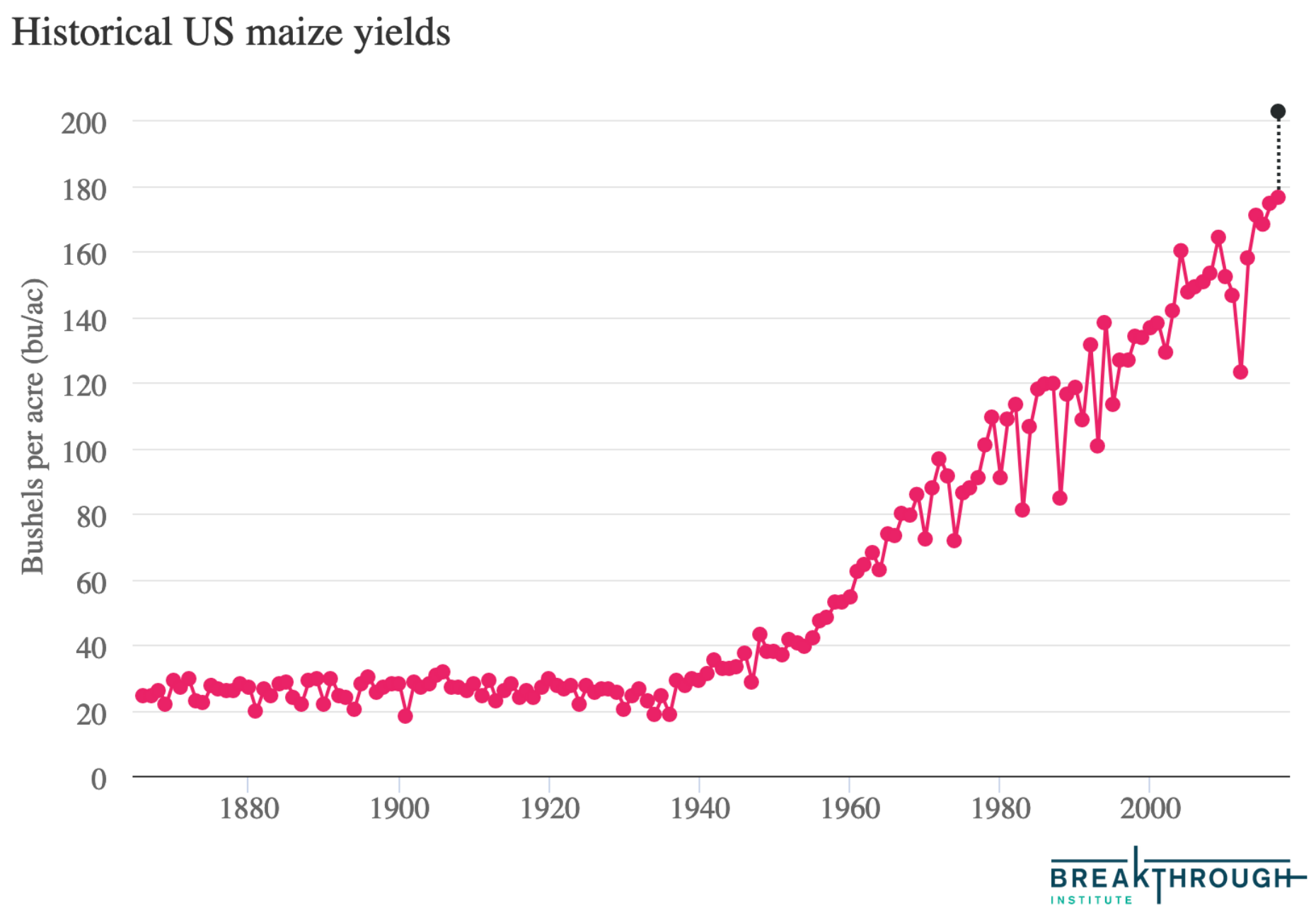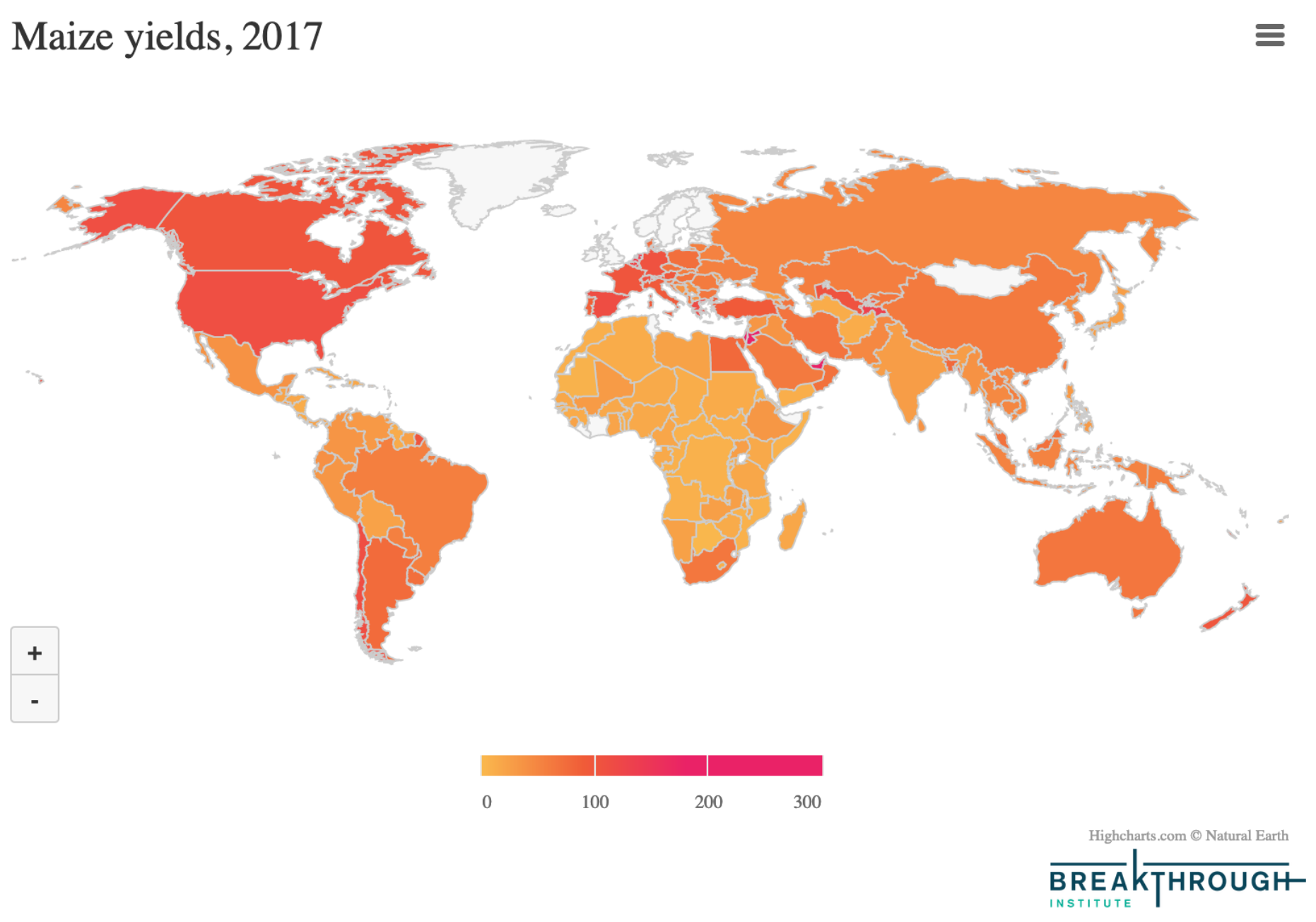Genetically Engineered Crops Are Key to Lower-Carbon Agriculture
-
-
Share
-
Share via Twitter -
Share via Facebook -
Share via Email
-
As governments and industries work toward a net-zero future, the food system remains a stubborn source of one-third of total global emissions. While some new technologies are finally nudging carbon outputs in the right direction, one underutilized technology stands out as a climate game-changer — genetically engineered crops.
In 2018, greenhouse gas emissions from the global food system totaled 16 billion tons CO2 equivalents per year (GtCO2e/yr), and of global food system emissions, a quarter (about 4 GtCO2e/yr) comes from conversions of natural ecosystems to farmland. Our research shows that modifying key crops in the US with just one new genetically engineered trait could increase yields by 15%, thereby decreasing global food system emissions from land conversion by 5%, or 214 million tons CO2 equivalents per year (MtCO2e/yr). With the addition of two more genetically engineered (GE) crop traits, that yield increase could quadruple to 60%, causing dramatic emissions reductions on a global scale.
Crop yield increases have historically played a crucial role in limiting land conversion and associated emissions — without them, land use for cereal production would have expanded over 6 times more than it did. Improvements in crop genetics have contributed roughly half of historical yield gains, making yield growth a powerful way to reduce emissions.
Increasing crop yields by using genetic engineering to improve crop genetics has a large, but largely overlooked, potential to reduce agriculture's climate footprint. By some estimates, dramatic improvements in plant breeding, including genetic engineering, could reduce global agricultural GHG emissions by almost 1 Gt CO2e/year by 2050, mainly by increasing yields.
Historically, most GE crops commercialized in the US were not designed explicitly to increase yields, but that is changing. A long-pursued application of genetic engineering in agriculture has been to improve photosynthesis in crop plants because photosynthesis is a key determinant of crop yields. Plant breeding has led to huge agricultural improvements, but photosynthesis is a process that can’t be improved much using conventional breeding. Until relatively recently, improving photosynthesis in field crops was hypothetical. But three studies published from 2016–2020 through the National Science Foundation-funded Realizing Increased Photosynthetic Efficiency (RIPE) project show crop yield increases of 15–40%from different GE traits that improve photosynthesis by improving adaptation to changing light, detoxifying photosynthetic byproducts, and adding cellular machinery. All these traits combined could increase crop yields by a revolutionary 60%, compared to the 1–3% average annual yield increases in US corn, soybeans, and wheat since the 1960s (Figure 1).

If we apply just one RIPE-developed improvement to photosynthesis with the smallestWe use the low end of yield increases achieved through RIPE research as a conservative estimate. Results will vary with different traits across different growing conditions, but gains from all three of these traits together would likely be consistently above 15%.yield increase to the five most widely-grown GE crops in the US, avoided emissions could total 214 million tons CO2 equivalents per year (MtCO2e/yr). If this photosynthetic improvement were also adopted on half the US acreage of wheat — we assume lower adoption because no GE wheat is currently grown in the US — avoided emissions could total 221 MtCO2e/yr.
Of this total 221 MtCO2e/yr in emissions avoided, Figure 2 above shows that the vast majority is due to avoided emissions from land-use change, with only small increases or decreases in production emissions. Avoided emissions from land-use change are based on the assumption — built into the Carbon Benefits Calculator we use from Searchinger et al. (2018) — that increased crop production in one location leads to a proportional decrease in production and related land-use change elsewhere. Because the US typically has higher crop yields than the global average (Figure 3), increasing US production by growing GE crops with higher yields results in a net reduction of global agricultural land area and emissions.
We project that production emissions, on the other hand, would not change much. These include the emissions associated with inputs to production including fertilizer application, on-farm energy use, and production of fertilizer and pesticides. Since production emissions are measured per output, they only increase if higher input levels don’t lead to higher yields. The only crop for which production emissions would increase is soybean because cultivation in the US has higher emissions per bushel than the global average due to high fertilizer use. Figure 2 also shows that different crops contribute vastly different amounts of total emissions savings, due primarily to the total area on which they’re grown in the US, and secondarily to the difference between average US and average global yields for that crop.

To be sure, there are limitations to our analysis. In using theSearchinger et al. (2018) Carbon Benefits Calculator, we assume a 1:1 relationship between increased crop production in the US and decreased crop production elsewhere. While raising yields in one location does generally reduce the need to convert new cropland elsewhere (because global crop demand and production are rising), it is difficult to predict how land use will respond to crop yield increases in a particular situation because outcomes vary. However, even under the conservative assumption that only half of increased crop production in the US leads to decreased crop production elsewhere, the mitigation potential is still large at 109 MtCO2e/yr.
Of course, GE crops can mitigate the climate impacts of agriculture via mechanisms beyond increasing yields, and the two are not mutually exclusive. Another long-pursued goal of plant breeding is to make more crops, particularly grain crops, able to fix their own nitrogen — as legume crops like soybeans, chickpeas, and lentils do through a symbiotic relationship with bacteria that pull nitrogen gas out of the air and convert it to a form plants can use (production of synthetic nitrogen fertilizer also pulls nitrogen gas from the air but using an industrial process). More nitrogen-fixing crops could decrease the need for fertilizer application and related emissions of nitrous oxide, a potent greenhouse gas, as well as fertilizer runoff that pollutes waterways. Even crops bred for increased nitrogen use efficiency (i.e. how plants take up, assimilate, and allocate nitrogen) could achieve a portion of this impact. A 1% increase in nitrogen use efficiency of cereal crop production just in Brazil could decrease nitrogen fertilizer application by over 20,000 tons (compared to almost 2 million tons total applied to cereal crops in Brazil in 2011).
In order to fully benefit from agricultural applications of biotechnology, the US and other countries should make sure that regulations adequately mitigate risk without unnecessarily stifling innovation and commercialization of useful technologies. Likely all photosynthetic improvements will be achieved using transgenics, which involves the insertion of DNA from outside a plant’s species or natural breeding pool; and while the new 2020 SECURE rule for biotechnology regulation in the US is a dramatic improvement for non-transgenic traits, the regulation of transgenic GE traits is not substantially improved.According to RIPE scientists, traits developed through the project will take 15-20 years to pass through the US regulatory process. The SECURE rule first categorizes the level of potential risk from a GE trait based on the way it was engineered rather than the actual characteristics of the resulting plant, which is inconsistent with the factors that influence risk. By remedying this issue the USDA would better allocate resources and reduce the unnecessary regulatory burden on low-risk traits. Similar regulatory changes in other countries would allow more global benefit from GE technology in agriculture.
To maximize the environmental potential of biotechnology, countries must also allow for imports of human-edible GE foods such as wheat. Wheat is largely used for human consumption, while GE soybean, maize, cotton, canola, and sugarbeet mainly go to animal feed, non-food products, and/or highly processed products for human consumption (which contain little to no remaining genetic material). Regulations in many countries prevent the import of GE crops for human consumption, which has hampered the commercialization of GE wheat even in the US. A GE wheat could be commercialized and grown for human consumption domestically, but this would jeopardize wheat exports. Recently, Argentina approved the world’s first GE wheat for commercialization, but only after confirming that Brazil — which buys almost 50% of Argentina’s wheat exports — would accept the product for importation. These examples of GE wheat demonstrate that global regulatory change is needed to amplify the global benefit from GE crops.
Despite the greater potential benefit from GE crop adoption on a global scale, the climate benefits are clear even with the adoption of yield-enhancing photosynthetic improvements in the US. We show that using genetic engineering to improve photosynthetic efficiency in crops just in the US could increase yields by at least 15%, and thereby decrease global food system emissions from land conversion by 5%, or 214 MtCO2e/yr. With multiple improvements to photosynthetic efficiency, yields could increase by a revolutionary 60%, with a concomitant decrease in global food system emissions. Further emissions-reducing GE traits like nitrogen fixation and increased nitrogen use efficiency make it eminently clear that GE crops are powerful tools for making agriculture more climate-friendly.
Methods
In order to calculate potential avoided emissions from cultivation of crops with enhanced photosynthetic efficiency, we used a 15% increase in biomass yield at floweringA 15% increase in vegetative biomass, assuming 50% yield partitioning to vegetative biomass and 50% to reproductive biomass, results in a 15% increase in reproductive biomass: 0.5 vegetative/0.5 reproductive=0.15 increase in vegetative/x -> x=0.15 increase in reproductive. In modern grain cultivars about 60% of yield is partitioned to the grain, so 50% is a reasonable conservative value for maize and wheat (Long et al., 2006). Yield partitioning in modern soybean cultivars is approaching 60% (Koester et al., 2014). In modern canola cultivars, yield partitioning is around 40-50% (Zhang and Flottmann, 2016). Yield partitioning in sugarbeet ranges from 50-85% depending on how yield is calculated (De, Moore, and Mikkelsen, 2019; Hoffmann, 2019). For seed cotton, yield partitioning ranges between 55-65% (Pabuayon, 2020; Makhdum, 2007).as shown in field trials of tobacco by Kromdijk et al. (2016). Since Kromdijk et al. (2016) measured plant biomass at flowering, we assumed an average of 50% yield partitioning to the harvested product for our six crops, meaning that the increase in harvested product would be 15%. We then applied this yield increase to the top five most widely-grown GE crops in the US (soybean, maize, cotton, canola, and sugarbeet). We also applied the yield increase to wheat but assumed adoption on only half of wheat acreage since GE wheat is not currently grown or approved for production in the US. After 27 years of commercialized GE crops in the US, Argentina is about to commercialize the world’s first GE wheat.We used crop acreage and yield data from FAOSTAT, and fertilizer use data from Zhang et al. (2015). We modeled a scenario where a GE trait that increases crop yields by 15% was available in 2017 and adopted at the same rate as other GE traits in the US that year, using values for percent adoption from “Global Status of Commercialized Biotech/GM Crops in 2017,” (ISAAA).
When calculating production emissions using the Searchinger et al. (2018) Carbon Benefits Calculator, we entered site-specific values only for fertilizer application, using default values for on-farm energy use and energy used to produce fertilizer and pesticides; for fertilizer application, we made the conservative assumption that it increases in proportion to the increase in crop yield. When calculating the carbon benefits for each crop, we used the default carbon opportunity cost for each crop with the default 4% discount rate; under the scenario where only half of the increased crop production in the US leads to decreased crop production elsewhere, we reduced the percentage of replacement crops attributed to intensification to 50%.


